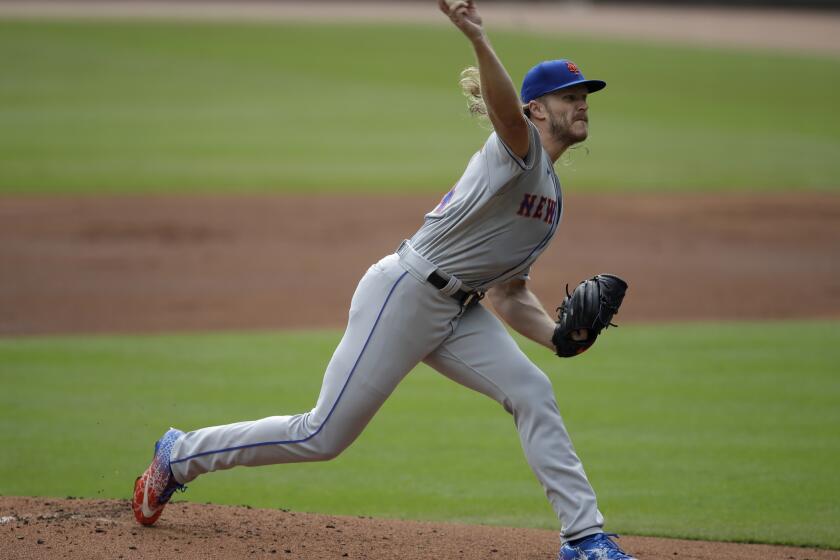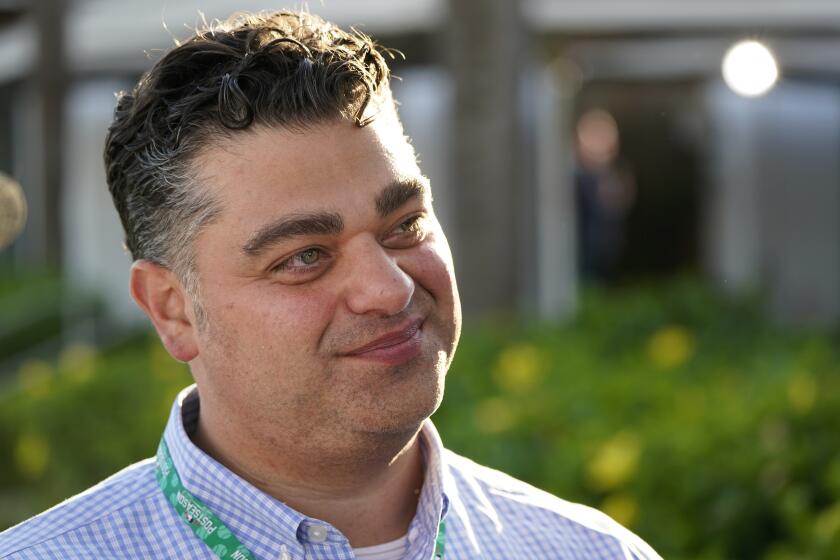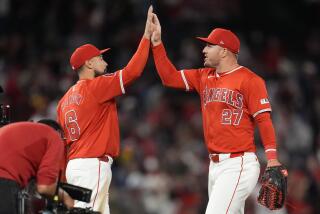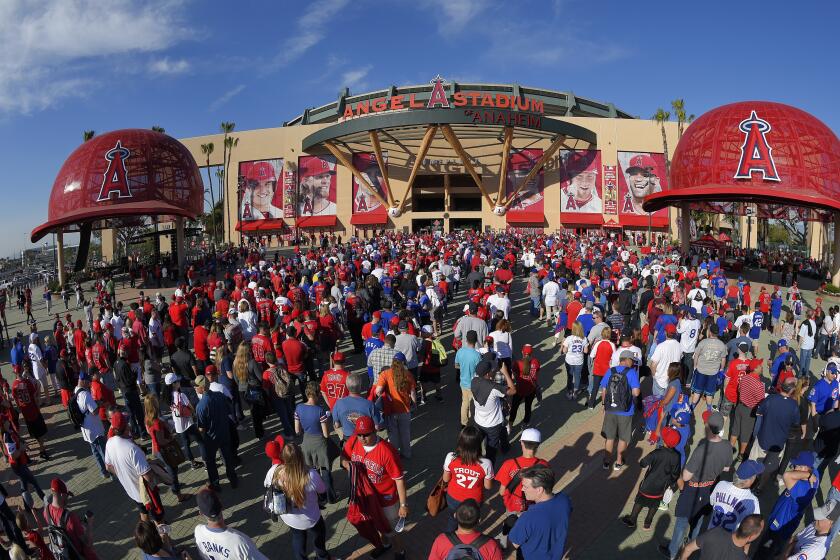Angels offseason: Three big questions after signing Noah Syndergaard
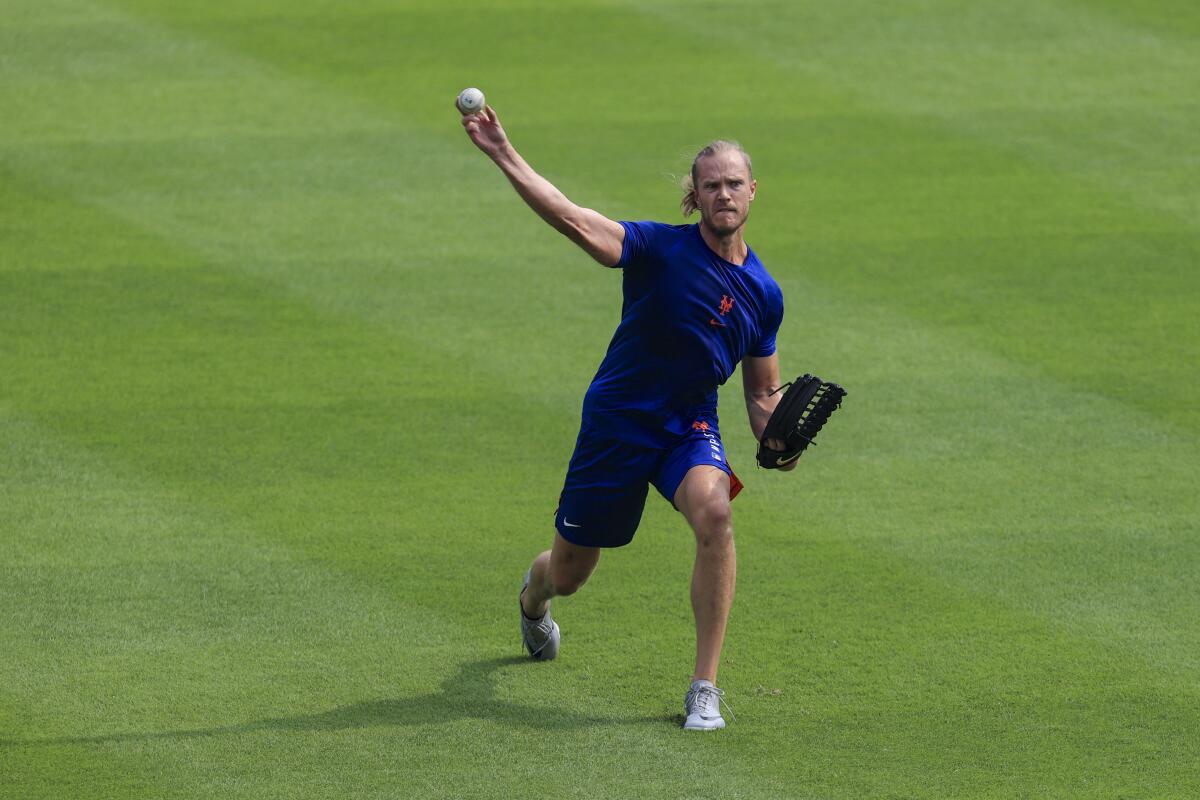
- Share via
He might not be José Quintana, Julio Teherán or Matt Harvey.
Yet the Angels’ signing of Noah Syndergaard alone might not be a surefire fix-all for their pitching staff, either.
In their first big move of the offseason, the Angels agreed to a one-year, $21-million deal with Syndergaard, the 29-year-old right-hander who was one of the game’s best young pitchers but has thrown only two innings the last two years coming off Tommy John surgery.
The deal would back up general manager Perry Minasian’s stated goal for this offseason: improving on the mound with “aggressive” arms who can set the tone for the rest of the staff.
What it likely won’t do, however, is relieve all the concerns for an Angels rotation that last season ranked 22nd in earned-run average, 26th in innings pitched and 16th in strikeout-to-walk rate.
With one big move now completed, here are three questions for the Angels.
Once a New York Mets phenom, Noah Syndergaard has pitched only two innings since 2019 because of injury. The Angels are banking on him bouncing back.
What moves come next?
Time will tell whether Tuesday’s news was a precursor to an even more notable offseason move, or if Syndergaard will be the Angels’ biggest addition this winter.
If the latter is true, the team could be making a big gamble.
Syndergaard has flashed sky-high potential, with a 3.32 career ERA, 26.4% strikeout rate and, when at full strength, one of the most impressive pitching repertoires in the game, complete with an upper-90s fastball and sinker complemented by a slider, changeup and curveball.
He and Minasian have a past connection. Minasian was in the Toronto Blue Jays front office when that club selected Syndergaard in the first round of the 2010 draft, then dealt him to the New York Mets in December 2012, where he spent the first six seasons of his big-league career.
But Syndergaard will come to Anaheim with plenty of questions. He’s been healthy only two of the last five years — he missed most of 2017 after tearing his right lat, then underwent Tommy John surgery just before the start of the 2020 campaign. He had a career-worst performance in 2019, when his ERA rose to 4.28.
He was still a coveted commodity this offseason. The Mets extended him an $18.4-million qualifying offer, and because of that, the Angels next year will have to surrender their second-round draft pick and $500,000 from their international bonus pool as compensation for signing him. There were other teams reportedly interested in Syndergaard, as well.
It remains unclear how close Syndergaard — who would be in line to earn the largest single-season salary ever by an Angels pitcher — is to being at his best.
If he is back at full strength, he could form a dynamic one-two punch with Shohei Ohtani. If he’s not, the team might still need more pitching to compete for a playoff spot.
Angels GM Perry Minasian spoke about the team’s pitching needs and approach during MLB’s general managers meetings on Tuesday in Carlsbad.
Where does the club stand financially?
All signs entering the winter pointed to the Angels trying to get multiple new arms to bolster their rotation.
But with Syndergaard on the books, it’s fair to wonder exactly how much room financially the team has left to go acquire more high-end talent on the mound.
According to Cot’s Baseball Contracts, the Angels entered the winter with just more than $130.5 million committed for next year, including estimated salaries for arbitration-eligible and pre-arbitration players. Syndergaard’s signing would raise that number to almost $152 million — which would be $30 million less than the team’s opening day payroll this year.
Bringing back closer Raisel Iglesias — something Minasian stated as a goal — would cut into the team’s financial flexibility even more. Iglesias will have to decide Wednesday to decide whether or not to accept his $18.4-million qualifying offer from the Angels. If he doesn’t, he should be in line to fetch a lucrative longer deal since top free-agent relievers in the last couple offseasons have earned contracts worth close to $15 million in annual average value.
If Iglesias does return, it means the Angels likely would have to either increase their payroll to get another top-tier starter such as Max Scherzer, Robbie Ray or Kevin Gausman, or go for a less-expensive choice such as Alex Wood, Steven Matz or Anthony DeSclafani. If Iglesias signs elsewhere, the Angels’ payroll would open up some, but the team would also have a new opening for a closer.
They could explore the trade market for pitching, where Luis Castillo of the Cincinnati Reds, Sean Manaea and Chris Bassitt of the Oakland Athletics, and Sandy Alcantara, Pablo López and Elieser Hernández of the Miami Marlins have been rumored to be available. That almost certainly would require the Angels to part with key players from an already thin farm system.
Not to be forgotten, the Angels also could benefit from more proven depth in the bullpen and their lineup.
Go beyond the scoreboard
Get the latest on L.A.'s teams in the daily Sports Report newsletter.
You may occasionally receive promotional content from the Los Angeles Times.
It’s all subtext to signing Syndergaard. The Angels might be getting one potentially impactful piece on the mound. But his addition alone is far from a guarantee that their roster will be significantly equipped to make the jump to contender status.
What version of Syndergaard might the Angels get?
Angel fans have seen moves similar to this fail to pan out.
Harvey, another one-time All-Star who battled injuries before coming to the Angels, had his lone season end in Anaheim in 2019 after 12 starts and a 7.09 ERA. Teherán, a two-time All-Star who had been a dependable starter in Atlanta, imploded with a 10.05 ERA in 2020. Quintana, another veteran pitcher expected to at least provide steady production, battled injuries and inconsistency last season before being waived with a 6.75 ERA.
Syndergaard should have a higher ceiling than that trio, who were also signed to one-year deals the last three offseasons, albeit at far less of a price.
Still, his health remains something of a question mark. In his return to the mound late last season, Syndergaard’s average fastball velocity dropped into the mid-90s over the course of two one-inning starts. He didn’t flash either of his breaking pitches in those outings either.
Next year, there could be decisions to make regarding his workload after throwing so little the previous two years.
Syndergaard, however, told reporters at the end of last season he was simply happy to get back on the mound and expected to be a “full go” for next spring.
“I definitely think I was able to showcase that I was healthy,” he said, according to Newsday. “Now it’s time to get back to the old Noah.”
That’s what the Angels hope they’ll be getting.
At his best, Syndergaard excels at generating whiffs (he has a career 28.3% whiff rate, almost four points above league average), limiting hard contact (his career-average 86.7-mph exit velocity against is almost 2 mph below league average) and racking up ground balls (his 49.9% career ground-ball rate is almost five points higher than league average).
At his peak, he could be a key missing ingredient for what the Angels need.
If he falls short of that, his $21-million price tag could become another failed investment for a franchise that has become all too accustomed to them.
More to Read
Go beyond the scoreboard
Get the latest on L.A.'s teams in the daily Sports Report newsletter.
You may occasionally receive promotional content from the Los Angeles Times.

